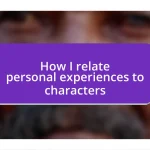Key takeaways:
- Emotional growth fosters resilience and deeper connections, helping individuals understand their feelings and navigate challenges more effectively.
- Techniques such as body language, storytelling, and creative arts serve as powerful tools for expressing and understanding emotions.
- Personal experiences, including failures and moments of vulnerability, can lead to significant emotional breakthroughs and strengthen relationships.

Understanding emotional growth importance
Emotional growth is vital for personal development, shaping how we interact with ourselves and others. I remember a time when I faced a significant setback at work. The initial feeling of defeat was overwhelming, but it became a turning point; I learned to embrace vulnerability and acknowledge my feelings. Have you ever considered how your struggles can lead to profound understanding and connection with yourself?
The importance of emotional growth lies in its ability to foster resilience. I’ve encountered situations that felt insurmountable, yet through reflection and learning from my emotions, I developed a stronger sense of self. Isn’t it fascinating how each challenge can deepen our emotional toolkit, preparing us for future obstacles?
Moreover, understanding our emotional landscape allows for healthier relationships. For instance, I once noticed that my explosive reactions were more about my unprocessed feelings than the situation at hand. This awareness brought me closer to my loved ones, letting them see my true self. Wouldn’t it be incredible if more people recognized the power of emotional honesty in nurturing connections?

Recognizing emotional challenges faced
Recognizing emotional challenges faced can often feel daunting, especially when we’re caught in a whirlwind of feelings. I remember grappling with unexpected sadness during what should have been a joyful moment, like celebrating a friend’s promotion. It struck me that those moments of happiness could also reveal deeper insecurities or fears. This realization is quite common; we often mask our emotional challenges under layers of social expectations or personal denial.
- Denial of feelings, such as pretending everything is fine.
- Overwhelm from unexpected changes, which can trigger anxiety or fear.
- Difficulty in articulating emotions, leading to frustration or miscommunication.
- Confronting past trauma that resurfaces in new situations.
- Struggles with vulnerability, making it hard to connect with others.
Recognizing these challenges is the first step to addressing them. I’ve learned to pause and reflect on my emotional responses, transforming confusion into clarity. It’s a journey of understanding that brings you face to face with the complexities of your heart, often leading to significant breakthroughs.

Techniques for portraying emotions
Techniques for portraying emotions can vary greatly, each offering unique avenues for expression. One technique I’ve found incredibly effective is the use of body language. During a challenging moment in my life, simply standing tall or maintaining open gestures allowed me to convey strength and vulnerability simultaneously. Isn’t it fascinating how non-verbal cues can speak volumes without uttering a single word?
Another powerful method involves storytelling. Sharing personal experiences helps us connect with others emotionally. I recall a conversation with a friend where I recounted a painful experience; I noticed how much more engaged they became as I painted the emotional picture vividly. This technique not only invites empathy but also fosters deeper connections. How have you used storytelling to express your feelings?
Lastly, I believe in the power of creative arts. Whether it’s painting, writing, or music, these mediums allow for a raw depiction of emotions. I once wrote a poem during a tough period. The act of putting my emotions into words was liberating. It transformed my pain into something beautiful, allowing others to resonate with my journey. Have you ever turned to art as an emotional outlet?
| Technique | Description |
|---|---|
| Body Language | Using gestures and posture to convey emotions non-verbally. |
| Storytelling | Sharing personal experiences to connect emotionally with others. |
| Creative Arts | Expressing emotions through mediums like painting, writing, or music. |

Personal experiences that shaped growth
One personal experience that profoundly shaped my emotional growth was a trip I took by myself. I remember standing on a cliff, watching the waves crash below. That moment of solitude forced me to confront feelings of loneliness I had avoided for so long. Have you ever found yourself in a situation that brought buried emotions to the surface? For me, it was a clarion call – I realized that silence could be uncomfortable but also transformative.
Another turning point came when I faced a significant failure at work. It was a project I had poured my heart into, and when it fell apart, I felt utterly defeated. However, instead of spiraling into despair, I chose to engage with my feelings of disappointment. I journaled about the experience, reflecting on what went wrong and what I could learn from it. I’ve learned that failures can be fertile ground for growth if we’re willing to dig deeper. Have you taken a moment to assess how your setbacks have shaped your journey?
Lastly, I vividly recall a moment with a close friend when we were having a deep conversation about our fears. As we shared our insecurities, I felt a wave of relief wash over me. It struck me that vulnerability was not a weakness, but rather a catalyst for connection. This realization opened doors to new friendships and strengthened existing ones. Isn’t it remarkable how sharing our struggles can lighten our emotional load? Through these experiences, I’ve come to understand that personal growth often flourishes in the face of adversity.

Overcoming obstacles in emotional portrayal
When I first attempted to portray complex emotions, I stumbled into overwhelming self-doubt. I can vividly remember acting out a scene where I had to display deep sadness. Instead of feeling authentic, I found myself more focused on whether I looked the part than on genuinely connecting with the emotion. Have you ever felt that way, caught in the web of wanting to show something true yet grappling with the fear of being vulnerable? It’s a challenge I faced head-on by reminding myself that authenticity is key; it’s about letting the feelings flow rather than performing.
Another obstacle I encountered was the fear of judgment from others. In a workshop, I shared my performance, and I could sense the skepticism from some peers. The knot in my stomach was palpable, yet I chose to embrace that fear. I learned to turn their potential criticism into motivation. Isn’t it liberating to think that what feels like a barrier can actually provoke personal growth? By accepting the risk of being judged, I discovered an empowering sense of freedom in my portrayal, allowing me to dig deeper into the emotional layers of my characters.
Lastly, navigating the ups and downs of emotional highs and lows taught me resilience. There were days when I felt completely drained, and portraying emotions felt like an uphill battle. During one particularly taxing week, I woke up struggling to channel happiness in a scene. Instead of forcing it, I channeled my fatigue into a quieter, yet powerful portrayal of melancholy. This experience solidified my belief that even in the face of emotional exhaustion, there’s always a unique perspective waiting to be explored. How do you transform your emotional struggles into strengths?

Tools for effective emotional expression
As I’ve navigated the journey of emotional expression, I’ve discovered that journaling has been an invaluable tool. There were moments when I felt a surge of emotions, but articulating them on paper helped me clarify my thoughts. Have you ever noticed how writing allows you to untangle your feelings and see them from a different perspective? I found that expressing emotions through words made me more aware of my triggers and patterns, leading to better understanding and growth.
Art also became a therapeutic outlet for me. I remember picking up a paintbrush during a particularly challenging time. As colors flowed onto the canvas, I could feel my emotions shifting. That experience made me realize how visual expression could convey feelings words often fail to capture. Have you ever tried expressing yourself through art? It can be a liberating way to open the door to those complex feelings residing within us.
Moreover, engaging in dialogue with trusted friends has been essential. I’ve had countless late-night conversations where vulnerability reigned supreme. These heart-to-heart chats not only foster connection but also offered me fresh insights into my emotions. Isn’t it extraordinary how sharing our thoughts with others can transform our understanding? I’ve learned that these exchanges create a safe space to explore my emotional depth, reaffirming that expressing feelings is not just necessary but profoundly healing.














